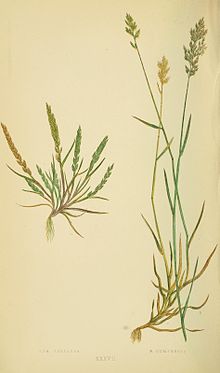Catapodium
| Catapodium | ||||||||||||
|---|---|---|---|---|---|---|---|---|---|---|---|---|
![Common stiff grass (Catapodium rigidum), illustration [1]](https://upload.wikimedia.org/wikipedia/commons/thumb/0/07/Catapodium_rigidum_HC-1950.png/300px-Catapodium_rigidum_HC-1950.png)
Common stiff grass ( Catapodium rigidum ), illustration |
||||||||||||
| Systematics | ||||||||||||
|
||||||||||||
| Scientific name | ||||||||||||
| Catapodium | ||||||||||||
| link |
Catapodium is a genus of plants within the sweet grass family(Poaceae). The four or so species are distributed almost worldwide. The common stiff grass ( Catapodium rigidum )occurs in Europe.
description
Vegetative characteristics
The Catapodium species are annual herbaceous plants that reach heights of 2 to 40 centimeters. The independently upright, knee-shaped ascending or lying stalks are simply or only slightly branched.
The alternately arranged leaves are divided into leaf sheath and leaf blade. The ligule is designed as a non-lashed membrane.

Generative characteristics
The inflorescences are panicles or compound grapes . The spikelets are pressed and stand individually. Fertile spikelets are sessile in two species and stalked elongated or wedge-shaped in the other two. Depending on the species, they have two to twelve fertile florets and small florets at the tip. The spikelets are elongated, wedge-shaped or obovate, laterally compressed and 4 to 12 millimeters long. The spikelet axis is glabrous, finely hairy in one species. The glumes are shorter than the spikelets and persistent. The lower glume is lanceolate or linear, slightly shorter to the same length as the upper, coarse, simply keeled or uncut (two species each) and shows one to five nerves, depending on the species. The upper glume is lanceolate, elliptical or ovate, pointed, shorter or about as long as the corresponding lemma, coarse, simply keeled or uncut and shows three or seven nerves.
The lemma of fertile florets is lanceolate, elliptical or oblong, coarse, keeled or uncut, wingless, five-nerved, glabrous or hirsute. The palea is slightly shorter to about the same length as the lemma, two-veined, glabrous or hairy. Two cavernous bodies and three stamens are formed per flower . The ovary is bare.
The fruits are ellipsoidal or concavo-convex caryopses . The embryo is about a quarter as long as the caryopsis. The hilum is point-shaped or elliptical.
Systematics and distribution
The genus Catapodium was established in 1827 by Heinrich Friedrich Link . Synonyms for Catapodium are Scleropoa Griseb. and Synaphe Dulac nom. superfl.
The genus Catapodium to the Untertribus Parapholiinae from the tribe Poeae in the subfamily Pooideae within the family Poaceae .
Two types occur in Europe, representatives can be found in Africa, Asia, Australia, North and South America.
Four species are assigned to the genus Catapodium :
- Catapodium demnatense (Murb.) Maire & Weiller : The homeland is Morocco.
- Catapodium mamoraeum (Maire) Maire & Weiller : The homeland is Morocco.
- Catapodium marinum (L.) CEHubb. (Syn .: Desmazeria marina (L.) Druce , Scleropoa loliacea (Huds.) Godr. , Catapodium loliaceum (Hudson) Link , Desmazeria loliacea (Hudson) Nyman ): The home is Macaronesia and the Mediterranean area to Western Europe.
- Common stiff grass ( Catapodium rigidum (L.) CEHubb. , Syn .: Desmazeria rigida (L.) Tutin , Scleropoa rigida (L.) Griseb. ): The two subspecies and one variety come from Macaronesia and from Europe to Iran and Djibouti in front.
Individual evidence
- ↑ Illustration by AS Hitchcock in Manual of the grasses of the United States . USDA Miscellaneous Publication No. 200. Washington, DC. 1950.
- ↑ a b c d e W. D. Clayton, M. Vorontsova, KT Harman, H. Williamson: Catapodium. In: GrassBase - The Online World Grass Flora. Royal Botanic Gardens, Kew, accessed November 1, 2014 .
- ↑ a b c d e f Rafaël Govaerts (Ed.): Catapodium. In: World Checklist of Selected Plant Families (WCSP) - The Board of Trustees of the Royal Botanic Gardens, Kew . Retrieved February 2, 2020.
- ^ A b Catapodium in the Germplasm Resources Information Network (GRIN), USDA , ARS , National Genetic Resources Program. National Germplasm Resources Laboratory, Beltsville, Maryland.
- ↑ German name after Hans Joachim Conert: Pareys grass book . Recognize and determine the grasses of Germany. Blackwell Wissenschafts-Verlag, Berlin, Vienna 2000, ISBN 3-8263-3327-6 , pp. 184 .